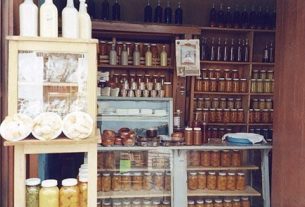Mexican Kitchen
Mention vanilla, and people are apt to think of the ice-cream flavor they select when confronted with a mind-boggling choice involving everything from chirimoya to cheesecake: “just plain vanilla.” What started out as one of the most exotic flavors to be introduced to the European palate has come to be equated with blandness. Even more astonishing, a plant once considered an aphrodisiac has, in recent years, become a label for less-than-exotic lifestyles, as evidenced by the disparaging use of the word “vanilla” by the self-proclaimed avant-garde. Just the sight of this tropical yellow-flowered orchid wrapping its vines around its neighbors would be enough to dispel this notion once and for all.
The use of this Mexican native plant by the Aztecs was first recorded by the faithful chronicler of the 1520’s Spanish expedition to central Mexico, Bernal Diaz. Ever observant of domestic details, Diaz made extensive notes on the culinary customs of the New World, especially those of the emperor Moctezuma’s court, where ground vanilla beans flavored the royal chocolatl beverage. Called tlilxochital, meaning in this case “black pod”, the plant was one of the rarer tributes paid from outlying parts of the empire, most notably by the Totonacs of the tropical highlands of Veracruz.
So jealously guarded were the Totonoc’s secrets for curing the vanilla pods that they were said to have sworn terrible oaths to discourage outsiders from obtaining knowledge of the subject. Nevertheless, the Spaniards imported the already-cured pods to Spain in the early days of the conquest. (The word vanilla is derived from the Spanish vainilla, meaning “little pod.”) It was not until the 18th century, however, that the cultivation and curing process was taken up by Europeans, not the Spanish but the French.
The French colonists in the state of Veracruz began by cultivating vanilla in its native soil, but were deterred by the fact that the plant’s natural polinators, meliponid bees, were not the most efficient, and slowed production considerably. It was not until the French began to grow vanilla in climate controlled greenhouses in France that experiments in artificial fertilization yielded a much greater crop production. The French, who then began to use this method in Veracruz, were accused by the Totonocs of stealing their crop and were forced to share their new and improved technology. Thus gave rise to the fascinating story of the Totonoc vanilla barons.
The Totonocs, with their ancient knowledge of the plant, along with the new fertilization methods, became wealthy exporting vanilla pods. One of the first things they did with their new-found riches was to travel to France. Chartering transatlantic ships for themselves, they arrived in Paris, accompanied by French-Totonoc translators, and enjoyed the best the city had to offer, including architects who designed fabulous mansions for them. To this day, one of these buildings stands on the Rue Saint Germain, with Totonoc motifs incorporated into its facade.
The Totonocs’ curing methods were many and varied, and several are still used today, including sun-drying, drying over wood fires, and “sweating” to release the plant’s natural enzymes. Although Mexican vanilla is considered by connoisseurs to be the most fragrant in the world, the pods do not have their distinguishing fragrance when plucked from the flower. It is only the cured product which releases this delicious aroma.
While now cultivated in other parts of the world, including the former colonies which made up French Polynesia, it is in Mexico where vanilla’s ancient secrets are best kept. Among these is the fact that, when allowed to over ripen so that the pods split, the flavor of vanilla is at its finest. While unsuitable for a large export market, these pods are carefully harvested and sold to gourmets the world over, willing to special-order them direct from the source.
The Gaya family of Papantla Veracruz are among those who cater to this select clientele. Travelers to Papantla may buy them from the family. This particular journey is not as far afield as one might imagine, because the charming town of Papantla is the closest place to stay when visiting the impressive pre-Colombian site of El Tajin, famous for its many-windowed pyramids. This month, in fact, is the time when the indigenous people celebrate their precious crop with the annual Festival de Vainilla. The fair features local culinary specialties, as well as the “flying dancers” called voladores, who execute their ritual performance from poles as high as fifty feet off the ground. Intricate figures woven from vanilla pods are also for sale here, and make unique, one-of-a-kind gifts, to be used as sachets.
The following recipes reflect the ingenuity of the regional culinary uses of vanilla. In addition to its use in flan and other sweets, vanilla is a wonderful flavoring for chicken, shellfish and vegetable dishes. While this revelation may be startling for most home cooks, the fact is that vanilla has long been an ingredient in some of the finest French dishes, including lobster served in a vanilla and chive sauce, a descendant of the wonderful culinary exchange that took place between the French and the Totonacs. (The indigenous word for “fork”, a utensil introduced to the area by the French, is a delightful example of this exchange – the French fourchette became, and still is, fourchetl to the region’s locals.)
Those interested in obtaining the aromatic split vanilla pods may contact the Gaya family at Avenida Hidalgo #56, Gutierrez Zamora, Veracruz.
- Mexican braised chicken with vanilla: Pollo al vainilla
- Papantla style shrimp: Camarones xanath
- Mexican steamed carrots with vanilla: Zanahorias al vapor con vainilla
- Mexican vanilla flan: Flan de vainilla
- Mexican plantains with vanilla cream: Postre de plátano con vainilla


